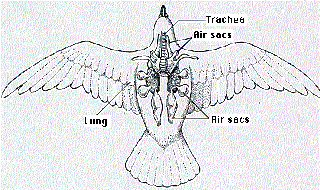Imagine that you could magically grow bird wings, plus the muscles to power them. Would you immediately set off for the great blue horizons or perhaps take a migration to Florida for the winter?
Unfortunately, you would not get very far. If he or she could grow feathers and wings, even a marathon runner would quickly become too exhausted to flap those wings or even to take off. Our lungs, and the lungs of most vertebrates, are simply not efficient enough to meet the metabolic requirements of flight. Birds, however, possess amazing adaptations that make their respiratory systems one of the most powerful in the animal kingdom. The structure of the avian respiratory system is an essential adaptation that makes flight possible.
A respiratory system must exchange the carbon dioxide in the blood stream with oxygen from the atmosphere. The system accomplishes this through simple gas diffusion and ventilation. In mammal lungs, gas diffusion and ventilation occur in the same organ. The fresh, or “good” air flows into the lungs, gas exchange occurs, and then “bad” air flows back out. As a result of this 2-way flow into and out of the lungs in the same passages, the good air is mixed with the bad air. So, the oxygen diffuses across the membrane of the lungs at a lower rate.
However, in bird lungs, the tasks of ventilation and gas exchange take place in two different organs. Their relatively small fixed lungs perform the gas exchange, and nine air sacs throughout their body act as bellows that provide the ventilation. These air sacs also integrate with bone tissue, helping to lighten the overall body weight. The air sacs also allow for a nearly constant, one-way airflow and volume in the lungs, which greatly increases efficiency. Since “fresh” air brings in a higher concentration of oxygen with hardly any mixing of good air and bad air, oxygen is able to diffuse more quickly into the bloodstream.
Recent evidence shows that predatory dinosaurs had similar respiratory systems to modern birds, including fixed lungs and air sacs. The air sacs may have lightened the dinosaur’s skeleton, allowing it to walk upright.
Sources
Submitted by Leah Sainz, World Bird Sanctuary Naturalist


2 comments:
Great post, Wonderful information about avian respiratory system. Its an excellent post. The idea is to capture, remove and dilute pollutants emitted in the space to reach a desired, acceptable air quality level.
ryna
I really enjoyed this informative article!
Pat OBriend
Post a Comment